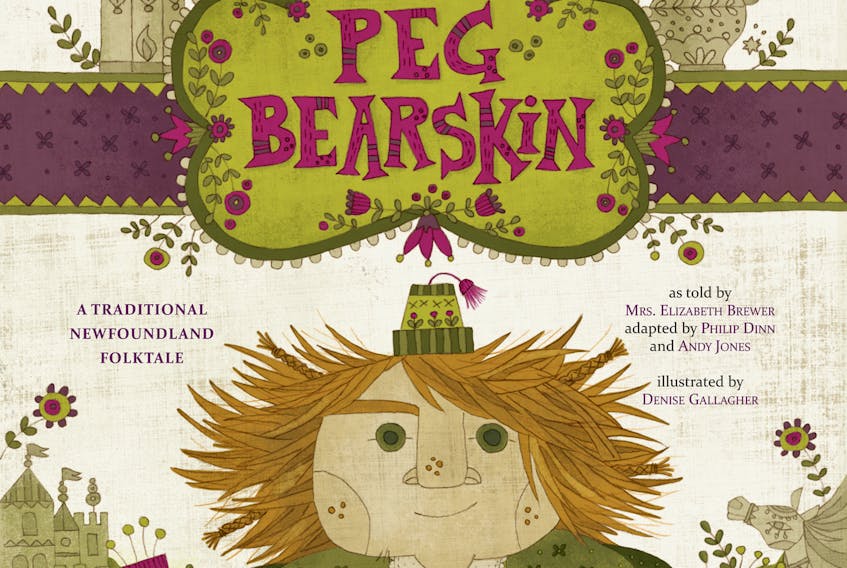
Folk tales often hatch fairy tales, but they aren’t quite the same thing. Though both often involve wonderment and magic, folk tales are inherently part of an oral tradition. This is clearly depicted by the text and tone — no, voice is a better word, as this is clearly spoken — with “Peg Bearskin”:
“One time, in olden times, not in my time, there was a man and a woman, and they got married and they never had any children. They were a long while and never had no children, and, well, her husband, he was real nasty to her …”
The usual central female figures in fairy tales are imperilled princesses, of royal blood and with limited, though vital, access to true love. Albeit often resourceful (though palace-raised, able to adequately keep house for seven, etc.) they are targeted for their beauty and innocence (i.e. poisoned apples, or tricky spells regrading unusual monikers).
Not so our heroine. “Peg’s big, ugly, and hairy, yes, but she’s also smart enough and brave enough to outsmart a witch, help a king, and find husbands for her two beautiful sisters …”
As we learn, the abovementioned grieving barren woman is advised by a passing old man that she will find three berries, “one as sweet as molasses” and “one as sweet as sugar,” and a third “bitter as the gall.” She is to eat the first two but not the third.
But, she eats all three.
The result is three girls, “two, oh, they were as pretty as ever the sun shined on.” The third is Peg.
“Now the three girls, they grew up together but nobody liked Peg, nobody. Whatever way it was. And her sisters, well, they were getting kinda fed up with her for some way or another. And they said to the mudder, they said, we’re going away, they said, unknown to Peg. ‘Cause, they said, they didn’t want her going with ’em. So they went.”
Peg is not so easily daunted, though.
She discovers their ploy, and follows. She is loyal and protecting and soon displays talents her sisters have either overlooked or taken for granted. For example, on the first night of their adventure, they find “this little hut of a house,” and knock on the door, requesting shelter. The “little old woman” within agrees, with the caveat; “I only got the three beds, and I got me two daughters. I can keep two of ya, she said, but I can’t keep three.
“And Peg said, well she said, it don’t make no matter to meself where I goes, long as I got a place for me two sisters.”
Peg ends up on the floor, uncomfortable and unable to sleep. But thank goodness, because her restlessness allows her discover that the old woman is a witch, with two marvelous possessions — and dire plans for Peg’s sisters.
In the first of a series of tactical triumphs, Peg foils the witch’s plot, and all three escape, while her knowledge of the sorcerous spells abiding in the witch’s house will help her achieve some lofty goals down the road.
“Well now, after a while, Peg’s two sisters, they got jobs doing something or other. I don’t know what Peg was at all the time, but there was a king there, and he had three sons.
“Now one day Peg minded she was goin to go and see the king. So she walked up to the palace gate and the guard asked her what did she want.
“Well, she says, I want to see the king.
“So all right, the king was satisfied for her to come and see him, whatever way it was …”
The green-and purple palette of Denis Gallagher’s artwork, with its patchwork naive perspective, sweetly and handily accompanies the tale.
As integral to appreciating such lore, an informative endnote tells readers that this piece was “included in the late Herbert Halpert and John Widdowson’s seminal work ‘Folktales of Newfoundland: The resilience of the oral tradition’ … As Halpert and Widdowson note, there are many stories related to, or sharing motifs and parallels with, “Peg Bearskin,” including “Molly Whuppie” and “Kitty Ill-Pretts” from Scotland, and “Hairy Rouchy” in Ireland. Peg’s extended family reaches across continental North America, to include an Ojibwa version collected in Wisconsin and related Francophone tales in Quebec; similar tales can also be found in Scandinavia.”
It also gives a more recent history of recitation and performance for this gallant champion.
Joan Sullivan is editor of Newfoundland Quarterly magazine. She reviews both fiction and non-fiction for The Telegram.
Previous column:
JOAN SULLIVAN: ‘18 Souls’ focuses on the loss and legacy of Cougar Flight 491









